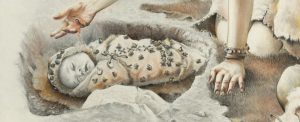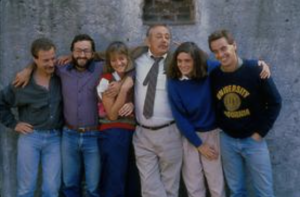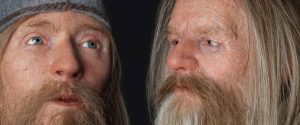In 1897, sausage factory owner Alfred Luetgert, known as Chicago’s Sausage King, was convicted for the murder of his wife, Louisa. In order to dispose of the body, he burned it and then boiled it in caustic potash in a vat in his sausage factory, dissolving most of the remains. However, some evidence of Louisa Luetgert’s body was found in the factory, which was central to the trial. At the bottom of the vat, detectives discovered small bones and two rings, one of which was a wedding ring engraved with the initials “L.L.” (Schecter). In a pile of ash, detectives found “more bone fragments, as well as a false tooth, a hairpin, a charred corset stay, and various scraps of cloth” (Schecter).

A diagram of the 2 foot bones found at the scene of the crime, and where in the foot they came from. Originally printed in the Chicago Journal. Source: chicagology
Archaeologist George Dorsey, one of the first Americans to earn a PhD in anthropology (Pauls), was an expert witness at the trial. The defense argued that the fragments were animal bones from the sausage making process. However, Dorsey testified that the fragments were human, and included parts of the skull, rib, metatarsal bones and phalanges of the foot (Bansal), and thigh bone (Schecter). He also identified the bones as female. Dorsey’s expertise was one of the factors that led to Adolph Luetgert’s conviction. Luetgert was sentenced to life in prison (Schecter). Dorsey’s testimony on this high-profile case was the first application of anthropology to a forensic setting. It also introduced forensic anthropology to the morbid imagination of the American public. The case had such an impact that the consumption of bratwurst in America declined to a record low (Snow 1982, 100).
More recent review of the case brings some of Dorsey’s testimony into question. Anthropologists generally avoid expressing such high confidence in the sex of remains. In the Luetgert case, the evidence was also heavily damaged and fragmented, further complicating sex identification. Forensic anthropologist Clyde Snow suggests that the question of certainty is not the result of Dorsey’s specific analysis, but rather the result of a persisting interaction between the scientific method and the American legal system. As a scientist, Dorsey would have normally provided nuanced information about his specific degree of certainty, which was evidently higher than completely indeterminate, but not necessarily very high, but, as someone testifying in court, he was legally required to simply provide an opinion, which – according to Snow – does not include certainty or probability (Snow 1982, 101). This limits the ability of scientific consultants to provide full information, and it is an issue that extends beyond this case, and even beyond the field of forensic anthropology.
The legal system is a lot better with the knowledge provided by forensic anthropologists. But there can be difficulties with proper scientific communication in the courtroom. This means that we need to carefully consider the relationship between law and science. The field of forensic anthropology must include discourse about how experts can best express themselves in the legal system, and how to possibly change the legal system to better accommodate scientific nuance.
Bansal, Pranshu. “Feel It in the Bones: Forensic Anthropology.” Crime Scene to Court Room. Jindal Global University, January 10, 2017. https://jguforensics.wordpress.com/2016/03/25/feel-it-in-the-bones-forensic-anthropology/.
Pauls, Elizabeth Prine. “George A. Dorsey.” Encyclopædia Britannica. Encyclopædia Britannica, inc. Accessed October 2, 2022. https://www.britannica.com/biography/George-A-Dorsey.
“Sausage Vat Murder.” chicagology. Accessed October 2, 2022. https://chicagology.com/notorious-chicago/sausagevatmurder/.
Schecter, Harold. “The ‘Sausage Vat Murder,’ 1897.” The Yale Review. Yale University. Accessed October 2, 2022. https://yalereview.org/article/sausage-vat-murder-1897.














